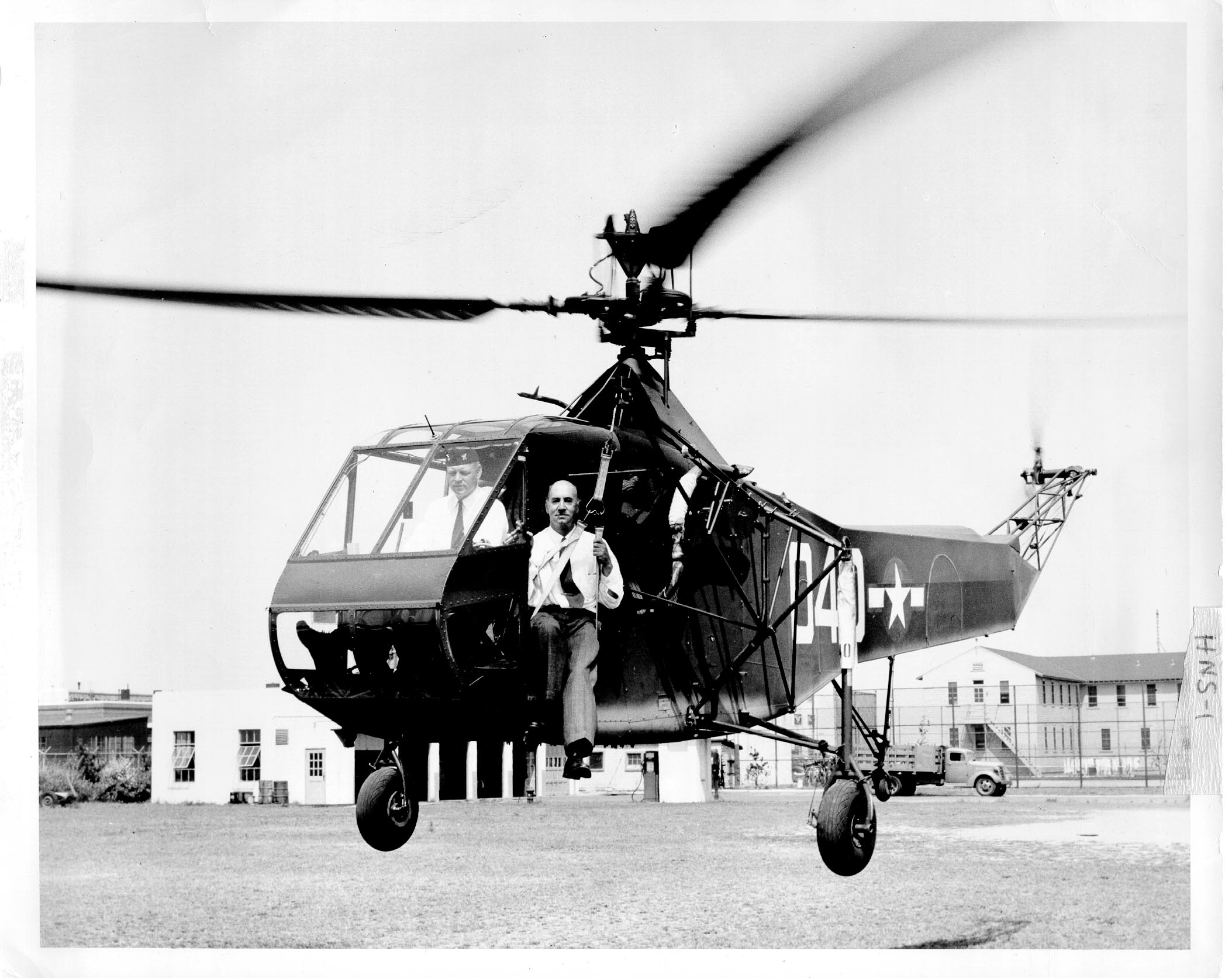- Sikorsky R-4
infobox Aircraft
name = R-4 / Hoverfly
type =Helicopter
manufacturer = Sikorsky
caption = Comdr. Frank A. Erickson, USCG & Dr. Igor Sikorsky, Sikorsky Helicopter HNS-1 C.G. #39040.
designer =Igor Sikorsky
first flight =13 January 1942
introduced =
retired =
status =
primary user =United States Air Force
more users =United States Navy United States Coast Guard Royal Air Force
produced = 1942-1944
number built = 131
unit cost =
developed from =Vought-Sikorsky VS-300
variants with their own articles =Sikorsky H-5 The Sikorsky R-4 was "the world's first mass produced
helicopter and theUnited States Air Force 's first service helicopter" [http://www.nationalmuseum.af.mil/factsheets/factsheet.asp?id=518 National Museum information] ]Development
The VS-316, was developed from the famous experimental VS-300 helicopter, invented by
Igor Sikorsky and publicly demonstrated in 1940. The VS-316 was designated the XR-4, under theUnited States Army Air Forces ' series for "Rotorcraft". The XR-4 made its initial flight on13 January ,1942 and as a result of its successful flight tests, theUnited States Army Air Forces ordered three YR-4As and 27 YR-4BsFact|date=April 2007 for service testing and flight training.Operational history
The R-4 was first used in combat in May 1944. In a letter to a friend, Col.
Philip G. Cochran , commanding officer of the1st Air Commando Group , wrote "Today the 'egg-beater' went into action and the damn thing acted like it had good sense." The R-4 showed such promise that the AAF ordered 100 R-4Bs.Of these 30, one went to Burma and one to
Alaska , while several others were assigned to theUnited States Navy ,United States Coast Guard andRoyal Navy who named it the Gadfly. InRoyal Air Force service it was called the Hoverfly. The R4 equipped the first British military unit to be equipped with helicopters, the Helicopter Training School, formed in January 1945 atRAF Andover .Variants
External differences noted in photos: Some R-4s had the tail wheel located at the extreme aft end of the boom near the tail rotor while others had it positioned at the mid-point of the boom. Additionally, some had short "stub" exhaust pipes from the engine while others had a much longer one which extended vertically and then aft above the main landing gear struts.
;XR-4:One prototype Model VS-316A with a crew of two and dual controls, 165hp R-500-3 engine, became XR-4C;YR-4A:Version with larger rotor diameter and a 180hp R-550-1 engine; three built.;YR-4B:Version with detailed changes. 27 built for development testing followed by a further batch of 14, seven to US Navy as HNS-1s. ;R-4B:Production version with 200hp R-550-3 engine. 100 built including 20 for the US Navy and 45 for the Royal Air Force.;XR-4C:Prototype XR-4 re-engined with 180hp R-550-1 engine with the larger YR-4A type rotor.;HNS-1:Three YR-4Bs and 22 R-4Bs transferred to the US Navy, two diverted to the United States Coast Guard.;Hoverfly I:UK military designation of the R-4 for the Royal Air Force and Royal Navy, 52 delivered and one later transferred to the Royal Canadian Air Force.;XR-6:Redesigned R-4B with 235-hp Franklin O-405-9 engine; one built.;R-6A:Production version of the XR-6. Six built by Sikorsky and 219 built under license by Nash-Kelvinator. [http://www.nationalmuseum.af.mil/factsheets/factsheet.asp?id=523]
Operators
;CAN:
Royal Canadian Air Force ;UK
*Royal Air Force
*Fleet Air Arm ;flag|United States|1912
*United States Army Air Force
*United States Navy
*United States Coast Guard Aircraft on display
* Smithsonian Museum's
Steven F. Udvar-Hazy Center has the XR-4C prototype
*National Museum of the United States Air Force atWright-Patterson AFB nearDayton, Ohio
*RAF Museum atHendon in northLondon
*Canada Aviation Museum inOttawa, Ontario
*National Museum of Naval Aviation inPensacola, Florida . Exhibit is an HNS-1 Hoverfly (Bureau Number 39047) - On indoor static display in US Coast Guard markings.
*Army Aviation Museum atFort Rucker , Alabama. U.S. Army R-4B Hoverfly (Serial Number 43-46592) and R-6A Hoverfly II (Serial Number 43-45473) on indoor static display. [U.S. Army Aviation Museum Association, Inc. [http://www.armyavnmuseum.org/museum/collection/rw3.html "Rotary Wing Collection"] . www.armyaviationmuseum.com.2 January 2003 . Accessed on25 August 2008 .]pecifications (R-4B)
aircraft specifications
plane or copter?=copter
jet or prop?=propcrew=1
capacity=
length main= 33 ft 8 in
length alt= 10.2 m
span main= 38 ft
span alt= 11.5 m
height main= 12 ft 5 in
height alt= 3.8 m
area main=
airfoil=
empty weight main=2,098 lb
empty weight alt=952 kg
loaded weight main= 2,581 lb
loaded weight alt= 1,170 kg
useful load main=
more general=
engine (prop)=Warner R-550
type of prop=piston
number of props=1
power main= 200 hp
power alt= 149 kW
power original=
max speed main= 75 mph
max speed alt= 120 km/h
cruise speed main= 65 mph
cruise speed alt= 105 km/h
never exceed speed main=
ceiling main= 8,000 ft
ceiling alt= 2400 m
climb rate main=
thrust/weight=
power/mass main=
more performance=
armament=
avionics=ee also
aircontent
related=
*Vought-Sikorsky VS-300
*Sikorsky R-5
similar aircraft=References
Notes
Bibliography
* Myall, Eric and Sturtivant, Ray (ed.). "The Hoverfly File". Tunbridge Wells, Kent, UK: Air-Britain (Historians) Ltd., 1998. ISBN 0-85130-262-9.
External links
* [http://www.nationalmuseum.af.mil/factsheets/factsheet.asp?id=518 Sikorsky R-4 page at the National Museum of the United States Air Force]
* [http://www.rafmuseum.org.uk/sikorsky-r-4b-hoverfly-1.htm RAF Museum Sikorsky R4 Hoverfly webpage]
* [http://www.plastikowe.pl/galerie/lotnictwo/sikorsky-r-4b-hoverfly-i Photo gallery of Sikorsky R-4B Hoverfly I]
Wikimedia Foundation. 2010.
